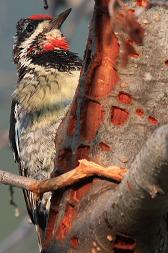Red-Naped Sapsucker 
Sapsuckers get their name from their habit of drilling
rolls of holes in tree trunks, and repeatedly coming back to
drink the sap.
Identification and Pictures
(Sphyrapicus nuchalis)
Red-Naped Sapsuckers are woodpeckers about 8
to 9 inches. The male has red patches on the forehead,
and throat. The back and sides are mostly black with
white spots. Their wings have a prominent white bar. The
belly is yellowish with a black breast patch above. The
head has two white stripes; one goes from above the eye to the
back of the neck, and the other from the beak to the
neck. Females have red, and white on throat.
Younger birds are mottled brown. Yellow
Bellied Sapsuckers look similar but do not have the red
nape. The two were considered to be one species but were
recently split up. They are often mistaken for the
smaller Downy
Woodpeckers.
Photos by Keith
Lee. The camera I use is the Canon
EOS 40D. Visit All-birds store

Sapsucker sounds
The drumming is several rapid thumps followed
by several slow thumps. The sapsucker's call is a soft nasal
cheer or mewing.
Preferred Habitat
In summer they can be found from British
Columbia through much of the western U.S. They migrate
south as far as Mexico in the winter. Sapsuckers likes coniferous, and deciduous
woodlands, as well as orchards. They are found often in willows,
aspens, and cottonwood.
Breeding and Nesting
During courting both birds will bob and swing
their heads while facing each other. They will also do
gliding displays. Sapsuckers nest in cavities in trees.
Both birds will excavate the nest, and may reuse an old cavity,
but usually make a new one. They do not line the nest except
with wood chips from the excavation. The female will lay
4 to 6 white eggs which both birds will incubate for around 13
days. Both birds will care for the young, which will
leave the nest in 25 to 29 days. The parents will feed
them for another 10 days.
Red-Naped sapsuckers Interbreed with both
Yellow-Bellied and Red-Breasted sapsuckers.
Food
Sapsuckers drill orderly rolls of small holes from which
they drink the sap. They also eat insects and fruits.
Their tongue is smaller than most woodpeckers, and has hair
like projections on the end which aid in sipping sap.
To learn about other favorite
birds click here.

|
